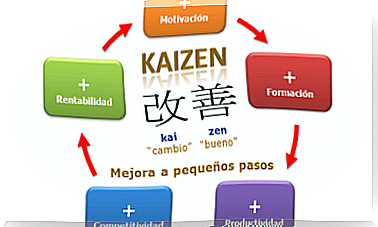5 Trust Dynamics For Children, Youth And Adults
Without confidence we would find ourselves in a permanent state of alert, with the idea that something would always be about to happen. For this reason, when working in a group, the proposals for trust dynamics should not be ignored, since feeling well-being and comfort with other people is crucial.
Confidence not only allows you to create a pleasant and safe space, but it also brings greater fluidity to personal interactions. To understand its importance, let’s think about how we are and how the body is when we are in an unfamiliar environment.
Surely the image that comes to us is that of a tense body and a worried mind. Now, let’s think about how that changes when we arrive at a place or when we are with a person that we feel like acquaintances. The feeling will be the opposite.
In addition, it is not something that is given or that is gained from one day to the next: trust requires time and gradual approaches. Ultimately, it is built. For this, the proposals of trust dynamics can work as a good starting point.
Confidence dynamics for all ages
Confidence dynamics can be worked with both boys and girls and adolescents, since they have a playful component that allows everyone to be entertained, while at the same time being committed to a common goal.
A moderator must be present in all dynamics, whose central role has to do with giving instructions to those who participate and monitoring that everything proceeds calmly and as planned. Therefore, you must be attentive and serve as an example in their attitudes and behaviors, taking into account that other social-emotional skills are also being worked on.

1. Balance between two
One dynamic to strengthen trust between members of a group is that of balance. To start the activity, what is needed is to work as a couple in a large space. No other types of materials are required.
The order consists of meeting in pairs, to which the game moderator must be attentive so that the pairs are uneven, that is, they do not share similar physical or bodily characteristics.
Couples should face each other, facing each other, with the tips of their feet touching. They should also hold hands.
Once they are all in this position, the person who moderates should give a signal and the pairs will begin to throw themselves backwards, as if dropping, but protected by their partner.
What is expected is that the first reactions will be insecurity and some fear, but then they will feel more relaxed. At that time, the moderator can add some difficulty to the game, such as indicating some turning movements or doing squats.
The activity can end in the agreed time or after the additional challenges proposed.
2. The wind and the tree
This trust dynamic is an adaptation of the previous one. As additional material a bandana or blindfold is required and the suitable location is a wide open space.
The participants should be arranged in a circle. At the center, a single volunteer will be the one to wear the blindfold and leave his body relaxed and flexible.
When the order is given, the group will begin to push and move the person in the center from one side to the other, as if they were passing it to another colleague who receives it. After a couple of times that the movements are repeated, another volunteer can be invited to take the place of the center.
The duration depends on whether everyone wants to be the center. Otherwise, the dynamics can take between 15 to 20 minutes.
3. The guide or be a guide in an obstacle course
Another of the trust dynamics for groups can be done in pairs in a large space. It is required to have objects of irregular shape, with a starting point and an arrival point.
One of the members must be blindfolded, while the other will be the one who will guide you with directions so that you arrive safely at the end of the circuit.
In this way, whoever is blindfolded will receive instructions such as “walk to the right, jump the hoop, take two steps to the left” , depending on the way the elements have been arranged. There may be rings, cones, and ropes.
The estimated time of the activity depends on the design of the circuit. Each member of the couple must occupy the role of guide and who is guided. It does not matter how long it takes to complete the journey, but rather the fact of arriving well and feeling confident while moving forward.
Each of the proposed dynamics reinforces group trust. The goal of the game, being shared, can only be achieved with the involvement of everyone, so it allows us to assess the importance of teamwork.
4. Fan of praise
Confidence can also be worked on in relation to oneself to learn to value personal positive aspects. Ideally, for this activity there should be at least a minimum of 6 participants and in a wide space so that they can be located in a circle.
It is a dynamic that requires prior knowledge of the group. The necessary materials are papers and something to write, such as a pen or pencils.
To begin, each participant is given a paper and a pencil and they are asked to write down their name. When they have finished, the signal is given and they are asked to pass the paper to the person on the left.
The moderator indicates that each one should write something positive or something they like about the name that is written on the paper, clarifying that comments or misplaced or inopportune words are not allowed.
When all the participants have written something about each of the group members, the moderator can start reading the paper or also ask a volunteer to do so. If the participants accept, it is possible to go a little deeper into what is written.
In this way, the activity aims at self-confidence based on what others see of us and the strengthening of self-esteem.
A variant is to put the papers in a box and have each person draw one at random. From there the roles begin to be exchanged.

5. Tell me what you draw
A last dynamic to work on trust and teamwork consists of separating the group into pairs and giving them a pencil and paper. The slogan is that one of the members of the couple must start by drawing a picture, making sure that his partner does not see what it is about. You will have a few minutes.
When everyone has finished, the moderator will give the signal and whoever made the drawing should give their partner clues to draw the same thing. By having to offer different explanations, this game allows you to develop and strengthen expression and communication skills.
The game ends once both members have created their own drawing and it has been guessed.
Sharing emotions as a goal of trust dynamics
At the end of the day of activities with the dynamics of trust, it is important that children, adolescents and adults have the opportunity to carry out an evaluation about how they felt, what they liked the most and what did not convince them so much. This provides a space for the expression and management of emotions.
The person who has the role of moderator will be the one who invites the participants to form a circle and share their experiences. It is also important to contextualize the activities, realizing the importance of trust and good interpersonal relationships in groups.
In this way, a climate is created in which it is possible to feel safe when sharing one’s own experiences and respect for listening is fostered.









